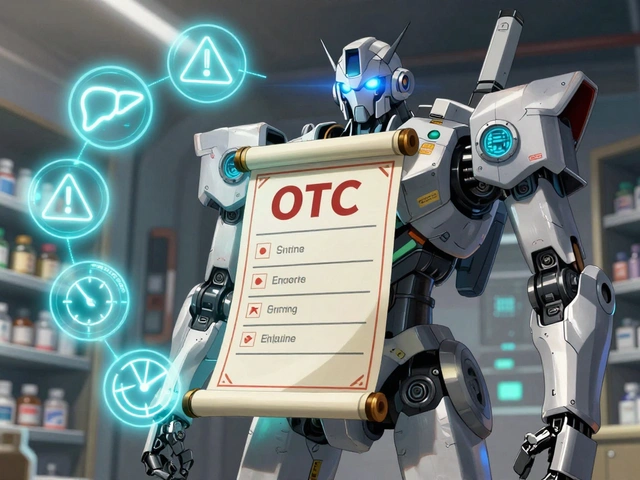What Is Ankylosing Spondylitis?
Ankylosing spondylitis (AS) isn't just back pain. It's a chronic autoimmune disease that attacks the spine and sacroiliac joints, turning healthy tissue into inflamed, stiff, and eventually fused bone. Unlike ordinary back pain that fades with rest, AS pain lingers for months or years - especially in the morning. People with AS often wake up stiff as if their spine is locked in place, and movement doesn’t help right away. The inflammation doesn’t stop at the spine. It can spread to hips, shoulders, heels, and even the eyes. Over time, new bone forms where it shouldn’t, fusing vertebrae together and limiting mobility. This isn’t normal aging. It’s a disease that starts young, often in the late teens or early 20s, and if left unchecked, can change how you move, work, and live.
Why TNF Inhibitors Are a Game-Changer
Before TNF inhibitors, treatment for AS was limited. NSAIDs like ibuprofen helped with pain, but they didn’t stop the inflammation from slowly destroying joints. Then came TNF inhibitors - drugs that target tumor necrosis factor-alpha, a protein that drives the inflammation in AS. Think of TNF-alpha as the alarm bell in your body that’s stuck on loud. TNF inhibitors silence that bell. They don’t cure AS, but they stop the damage in its tracks for many people. The first one, infliximab, got FDA approval in 2003. Since then, four others followed: etanercept, adalimumab, certolizumab, and golimumab. These drugs changed everything. For the first time, people with AS could go from being unable to get out of bed to walking without pain, working full-time, and playing with their kids.
How TNF Inhibitors Work
These drugs don’t just numb pain. They attack the root cause. In AS, immune cells flood the sacroiliac joints and spine, releasing TNF-alpha. This protein tells other immune cells to keep attacking, causing swelling, bone erosion, and eventually new bone growth. TNF inhibitors block this signal. Some, like infliximab and adalimumab, are monoclonal antibodies that latch onto TNF-alpha and neutralize it. Others, like etanercept, are fusion proteins that act as decoys - they trick TNF-alpha into binding to them instead of your joints. The result? Less swelling, less pain, and slower progression. MRI scans show clear drops in inflammation scores within weeks. One study found a 59% reduction in spinal inflammation after just 24 weeks of treatment. That’s not just symptom relief. That’s disease modification.
Which TNF Inhibitor Is Right for You?
Not all TNF inhibitors are the same. They differ in how they’re given, how often, and how long they last in your body.
- Infliximab (Remicade): Given as an IV infusion every 4 to 8 weeks at a clinic. Takes about an hour. Good for people who prefer fewer injections but don’t mind clinic visits.
- Etanercept (Enbrel): Injected under the skin twice a week. Has the longest real-world track record - many patients stay on it for over 13 years.
- Adalimumab (Humira): Injected every other week. One of the most prescribed. Also available as a biosimilar, which cuts costs.
- Golimumab (Simponi): Injected once a month. Convenient for people who want less frequent dosing.
- Certolizumab (Cimzia): Injected every other week or weekly. Unique because it doesn’t cross the placenta - often chosen by women planning pregnancy.
Response rates are similar across the board: about 60% of patients see at least a 20% improvement in symptoms within 12 weeks. About 40% see a 40% or greater improvement. But persistence varies. Etanercept and adalimumab tend to stay in use longer than others. Why? Probably because they’re easier to self-administer and have more predictable side effects.

Who Benefits Most?
Not everyone with AS responds the same way. The best candidates have:
- Bath Ankylosing Spondylitis Disease Activity Index (BASDAI) score of 4 or higher
- Spinal pain score of 4 or higher on a 10-point scale
- High CRP or ESR levels (inflammatory markers in blood)
- Shorter disease duration (under 10 years)
- Younger age (under 35)
One study found that if both CRP and another marker called serum amyloid A are high, there’s an 81% chance the patient will respond well to TNF inhibitors. That’s a powerful predictor. If your blood tests show low inflammation, TNF inhibitors might not work as well. That’s why doctors won’t prescribe them unless you’ve already tried NSAIDs for at least four weeks at full dose and still have active symptoms.
Real-World Results
Patients don’t just report feeling better - they report living better. A survey of over 1,200 people with AS found that 78% saw “substantial improvement” after starting TNF inhibitors. Morning stiffness dropped from over an hour to under 30 minutes for 62% of users. Many notice relief within two to three doses, though full benefits take up to 12 weeks. One Reddit user shared that etanercept cut his BASDAI score from 8.2 to 3.1 in eight weeks. That’s the difference between being bedridden and being able to drive to work. But it’s not perfect. Some develop psoriasis or eczema after starting treatment. Others get infections. About 15% stop because of side effects.
Safety and Risks
TNF inhibitors are powerful, and they come with serious warnings. The FDA requires a black box warning for all of them because they can:
- Reactivate latent tuberculosis (TB)
- Trigger serious infections like pneumonia or sepsis
- Worsen heart failure
- Lead to rare nervous system disorders
- Increase risk of certain cancers (though recent data shows no major increase in AS patients)
Before starting, you must be screened for TB and hepatitis B. If you’ve had TB before, you’ll need treatment to clear it first. You also need to avoid live vaccines while on these drugs. Common side effects include injection site reactions (redness, itching), headaches, and upper respiratory infections. These are usually mild. But if you get a fever, chills, or a persistent cough, call your doctor immediately. Infection is the most common serious side effect - reported in nearly 30% of adverse event cases.
What Happens If TNF Inhibitors Don’t Work?
About 30-40% of patients don’t respond well to the first TNF inhibitor. That doesn’t mean you’re out of options. Many people respond to a second TNF inhibitor - studies show 30-40% get good results after switching. If that doesn’t work, newer drugs called IL-17 inhibitors (like secukinumab and ixekizumab) are now approved and work just as well for many. These target a different part of the immune system. Some patients who failed TNF inhibitors respond brilliantly to IL-17 blockers. The choice depends on your symptoms, other health issues, and insurance coverage.

Cost and Access
TNF inhibitors are expensive. Humira cost over $20 billion in global sales in 2022. But biosimilars - cheaper copies - are now available. Amjevita, a biosimilar to Humira, entered the U.S. market in 2017 and now holds over 30% of the adalimumab market. These can save patients 15-20% on out-of-pocket costs. Insurance coverage varies. In countries with universal healthcare like Germany or the UK, 65-70% of eligible AS patients get TNF inhibitors within two years. In the U.S., it’s closer to 45-50% because of prior authorization hurdles and high co-pays. Some specialty pharmacies offer 24/7 nursing support to help with insurance paperwork and injection training.
What’s Next?
Research is moving fast. Scientists are now looking at gene markers like HLA-B27 subtypes to predict who will respond best. There’s also new drug development: next-gen TNF inhibitors that block only the harmful form of TNF (TNFR1) while sparing the protective one (TNFR2). Phase II trials for these are expected to start in 2024. Meanwhile, combination therapies targeting multiple cytokines at once are being tested. But for now, TNF inhibitors remain the gold standard. Over 20 years of real-world data show they reduce spinal damage by 50-60% when started early. They’re not magic, but they’re the most proven tool we have to keep people with AS moving, working, and living full lives.
Frequently Asked Questions
Can TNF inhibitors cure ankylosing spondylitis?
No, TNF inhibitors cannot cure ankylosing spondylitis. They don’t reverse existing bone fusion or eliminate the disease. But they can stop or slow inflammation, reduce pain, improve mobility, and prevent further joint damage. Many people achieve long-term remission - meaning symptoms are minimal or absent - while staying on treatment.
How long does it take for TNF inhibitors to work?
Some people feel better within days or weeks, but full benefits usually take 8 to 12 weeks. Pain and stiffness improve gradually. MRI scans show inflammation dropping as early as 12 weeks. Don’t stop treatment if you don’t feel better right away. Your doctor may adjust the dose or switch drugs if there’s no improvement after 3 months.
Do I have to take TNF inhibitors forever?
Most people stay on them long-term. Stopping often leads to flare-ups. Some patients who achieve deep remission may try tapering under strict supervision, but this is rare. Only about 30% of patients who stop treatment remain in remission. If you feel better, that’s because the drug is working - not because the disease is gone.
Can I take TNF inhibitors if I have a history of cancer?
It depends. TNF inhibitors carry a warning about cancer risk, especially lymphoma. If you’ve had cancer in the past five years, your rheumatologist will weigh the risks. For many types of solid tumors (like breast or colon cancer), treatment may be possible after remission with careful monitoring. But they’re generally avoided in patients with active or recent blood cancers.
Are biosimilars as good as the original TNF inhibitors?
Yes. Biosimilars are highly similar to the original drugs in structure, safety, and effectiveness. Studies show they work just as well for AS. Amjevita (adalimumab biosimilar) has been used by thousands of patients with no difference in response or side effects compared to Humira. They’re often cheaper and more accessible.
What if I’m pregnant or planning to get pregnant?
Certolizumab is the only TNF inhibitor proven not to cross the placenta, making it the preferred choice during pregnancy. Adalimumab and etanercept are considered low-risk but should be used with caution. Infliximab and golimumab are less studied. Always talk to your rheumatologist before trying to conceive - some drugs may need to be stopped months before pregnancy.
Next Steps
If you’ve been diagnosed with AS and still have pain after 4 weeks of NSAIDs, ask your rheumatologist about TNF inhibitors. Get your CRP and ESR tested - high levels mean you’re a strong candidate. If you’re nervous about injections, ask for a training session with a nurse. Many patients feel overwhelmed at first, but 92% master self-injection within a month. Keep a symptom diary. Track your morning stiffness, pain levels, and energy. That data helps your doctor decide if the drug is working. And don’t ignore side effects - report even small ones. Early intervention can prevent serious complications.





David Cusack
November 22, 2025 AT 04:47Willie Doherty
November 23, 2025 AT 12:22Darragh McNulty
November 24, 2025 AT 00:20Elaina Cronin
November 25, 2025 AT 23:17Franck Emma
November 26, 2025 AT 11:08Florian Moser
November 27, 2025 AT 17:15Nikhil Purohit
November 28, 2025 AT 23:02Michael Marrale
November 29, 2025 AT 15:48David vaughan
November 30, 2025 AT 16:15Logan Romine
December 2, 2025 AT 06:12Chris Vere
December 3, 2025 AT 17:18Pravin Manani
December 4, 2025 AT 18:26